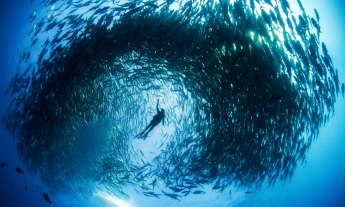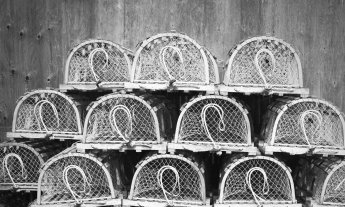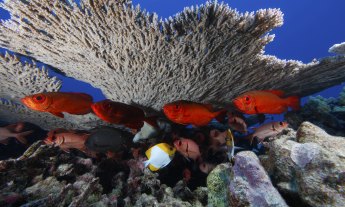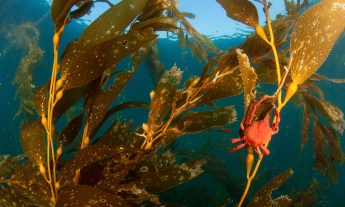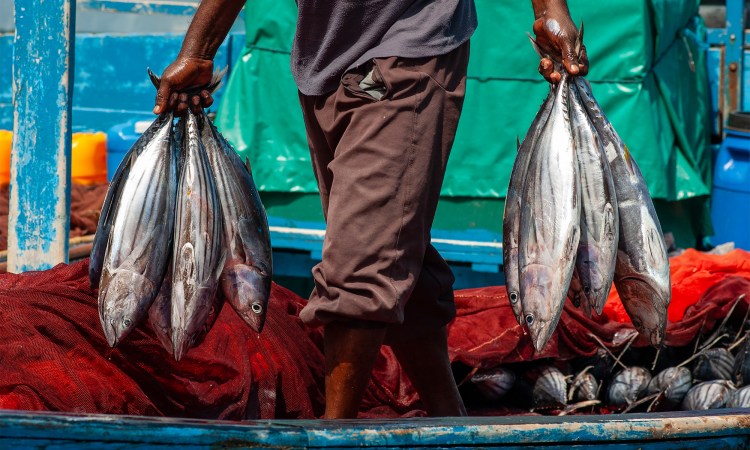
If you’ve seen Seaspiracy — the buzzy Netflix documentary that explores the harmful impacts of the commercial fishing industry — you might be rethinking your maritime menu choices. And while many experts have criticized the film for making misleading claims, it does raise an important question: Is it possible to eat seafood sustainably?
Consider this: Today roughly one-third of the world’s fish stocks worldwide are being overexploited and depleted. What’s more, the commercial fishing industry is depositing waste to the oceans, which are already polluted with millions of tons of plastic waste. For example, up to one million “ghost fishing nets” made from synthetic fibers are lost or abandoned every year. Marine animals — sea turtles, dolphins, porpoises, sharks, seals and other endangered marine species — often get caught in them or ingest pieces of them.
An overfished sea is a big problem — and it goes beyond our dinner plates. The oceans also play a key role in absorbing and storing large amounts of planet-warming carbon dioxide. Since the beginning of the Industrial Revolution, the ocean has absorbed more than 90 percent of the heat from human-caused global warming and about 33 percent of carbon emissions.
More fish swimming around means more carbon sequestration. Just like humans, fish breathe oxygen and release carbon dioxide. When a fish dies in the ocean — as opposed to it dying from being fished — it sinks and traps all the carbon it contains in the watery depths.
So, does this mean humans should stop eating fish altogether?
That’s neither realistic nor likely — small-scale fisheries and coastal communities in low-income countries are the main sources of nutrients for over one billion people on Earth. While plant-based alternatives can be a great option for some, they don’t work for all people and cultures.
Here are six ways you can make more sustainable seafood choices:
1. Diversify what you eat
Consumer demand for popular seafood, like oysters, means that certain species end up being overexploited while some abundant species are underappreciated. By diversifying our plates, we can help contribute to a more balanced marine ecosystem.
For example, shrimp is the most popular seafood in the United States. Unfortunately, both shrimp farming and shrimp trawling have devastating ecological consequences, including mangrove destruction, biodiversity loss and water contamination, and the shrimp industry has also been linked to forced labor in parts of Southeast Asia.
By contrast, mussels are a more sustainable option because they reproduce quickly and grow on rocks, pilings and large beds on the seafloor. Since not all seafood has an equal ecological footprint, Monterey Bay Aquarium’s Seafood Watch has a database of “best choices” and “good alternatives” for consumers around the world.
2. Remove endangered fish from the menu
It’s a critically important point and one that should be obvious: Eating endangered fish is bad for the environment. Sushi lovers, this category includes at-risk species like bluefin tuna, whose populations in the western Atlantic have declined by more than 82 percent in the last 40 years. Other species on the endangered or red fish list in North America are Atlantic codfish, Atlantic rock crabs and American lobster, even though they can slip through protection laws and end up on your plate. On the other hand, eating lionfish — an invasive species that’s also a prolific breeder — is a great choice (and their prey would thank you for it!).
Research suggests around 65 percent of seafood in the US is consumed at restaurants or other “away from home” sources, including schools, street stalls and bars. Asking questions about their supply chain — namely, where and how the fish were caught — and receiving accurate answers can help you make better choices. Plus, if more consumers express interest in ethical and sustainable seafood, it can incentivize the industry to change.
3. Find out how your seafood was caught
More than half the seafood we eat isn’t caught in the wild, explains marine biologist Ayana Elizabeth Johnson PhD in a TED-Ed lesson with Megan Davis. Instead, it’s cultivated — a practice that’s called aquaculture. Like agriculture, aquaculture practices can make a huge difference in the environmental impact of our diets.
One of the most common aquaculture methods involves storing fish in large pens made of nets. However, this not only produces large amounts of waste but because they’re not completely secure, it creates the potential for fish to escape and disrupt local ecosystems as invasive species. Choosing seafood from farms that employ more sustainable production systems, like secure tanks and wastewater treatment, can help reduce aquaculture’s footprint.
When it comes to wild-caught seafood, commercial fishers often use methods like purse seining and longlining, both of which catch hundreds or thousands of fish at a time. This results in a lot of bycatch, or unwanted fish, including the previously mentioned bluefin tuna. A study published in the journal Nature also showed that bottom trawling — an industrial fishing method that involves dragging weighted nets over the seafloor — can emit as much carbon dioxide annually as the aviation industry because it disturbs organic carbon stored in marine sediments. Methods like rod-and-reel fishing and hand lines are more sustainable ways to catch fish.
4. Eat “seasonally”
While the conversation around eating seasonally is usually reserved for fruits and vegetables, applying this thinking to seafood is also beneficial. Unlike produce, seafood seasonality is not dependent on the weather or climate but rather when fish populations are most abundant.
For example, a majority of peak-season salmon — the second-most consumed seafood in the US — comes from Alaska, where it’s abundant between June and September and typically peaks in June and July. If you’re purchasing salmon out-of-season in the US, buying frozen Alaskan salmon may be your best option since it was likely packaged during the peak harvest. (If you buy fresh out-of-season salmon, it risks being from a region where salmon stocks are consistently low, like the Pacific Northwest.) The downsides to frozen seafood are that it typically comes in plastic packaging and it requires additional energy for storage and transport.
While it’s hard for many people to keep track of the different fish seasons, your local grocer or fishmonger should be able to help you identify your in-season options.
5. Support local and Indigenous fisheries
For thousands of years, Indigenous fishing techniques have provided food to communities while maintaining balance in the rivers and oceans. One study of fisheries in the Pacific Northwest US and Canada suggested that using Indigenous fishing tools, like wheels and dip nets, could help revitalize declining salmon populations by causing less harm than industrial methods. In the Philippines, the Tagbanua people fish for specific species only during certain times of the year, which allows fish stocks to naturally replenish themselves. Native Hawaiians still practice cast-net fishing and spearfishing today, which significantly reduces unwanted bycatch.
By supporting a local Indigenous fishery, you’re not only investing in their businesses but in their sustainable knowledge and practices as well.
6. Utilize free resources
By now, you’ve gotten the message that Monterey Bay Aquarium’s global Seafood Watch tool can become your sustainable seafood best friend, but it’s not the only resource. The Environmental Defense Fund’s Seafood Selector can help you buy smarter at the grocery store, and local resources like New Zealand’s best fish guide can help too. If you’re still confused, talking to someone at a local fish store or local farmer’s market can be another great option.
Watch Ayana Elizabeth Johnson’s TED-Ed lesson and TED Talk to learn more about ocean health:








